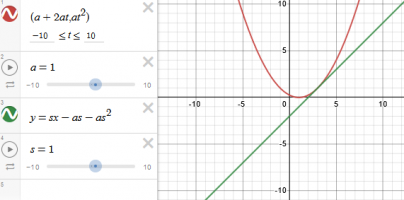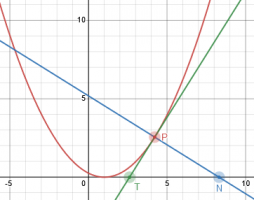You are using an out of date browser. It may not display this or other websites correctly.
You should upgrade or use an alternative browser.
You should upgrade or use an alternative browser.
conic section
- Thread starter Leons
- Start date
Harry_the_cat
Elite Member
- Joined
- Mar 16, 2016
- Messages
- 3,784
Where are you stuck? Are you given a specific point P?
I stuck after I find the slope. The question does not given a specific point P.Where are you stuck? Are you given a specific point P?
this is the slope that I get : [math](x-a)/2a[/math]
Dr.Peterson
Elite Member
- Joined
- Nov 12, 2017
- Messages
- 16,850
As I read the problem, the point P is specified by a parameter t, namely P [imath](a+2at, at^2)[/imath].I stuck after I find the slope. The question does not given a specific point P.
this is the slope that I get : [math](x-a)/2a[/math]
You are to find the slope at that point; your slope is correct as a function of x, so replace x with [imath]a+2at[/imath]. (The result is interesting!) Then find the equation of the line with that slope through that point.
can you check whether my answer is correct or not?As I read the problem, the point P is specified by a parameter t, namely P [imath](a+2at, at^2)[/imath].
You are to find the slope at that point; your slope is correct as a function of x, so replace x with [imath]a+2at[/imath]. (The result is interesting!) Then find the equation of the line with that slope through that point.
slope when x=a+2at
[math]\frac{a+2at-a}{2a}=t[/math]slope=t
tangent equation,[math](y-y_1)=m(x-x_1)[/math][math](y-at^2)=t(x-(a+2at))[/math][math]y=tx-at-2at^2+at^2[/math][math]y=tx-at-at^2[/math]
Dr.Peterson
Elite Member
- Joined
- Nov 12, 2017
- Messages
- 16,850
Yes, that's correct. As confirmation, I've graphed the parabola and the line:can you check whether my answer is correct or not?
slope when x=a+2at
[math]\frac{a+2at-a}{2a}=t[/math]slope=t
tangent equation,[math](y-y_1)=m(x-x_1)[/math][math](y-at^2)=t(x-(a+2at))[/math][math]y=tx-at-2at^2+at^2[/math][math]y=tx-at-at^2[/math]

Here, t is the parameter for drawing the curve, and s is a particular value of t to determine the point.
thank you so muchYes, that's correct. As confirmation, I've graphed the parabola and the line:
View attachment 32761
Here, t is the parameter for drawing the curve, and s is a particular value of t to determine the point.
topsquark
Senior Member
- Joined
- Aug 27, 2012
- Messages
- 2,370
You're dating yourself with that one!That was one hairy conic, Junior.
Excuse me, I mean Leons.
-Dan
hairy conic??That was one hairy conic, Junior.
Excuse me, I mean Leons.
topsquark
Senior Member
- Joined
- Aug 27, 2012
- Messages
- 2,370
i still dont understand?.. what does relate with him
i already got the equation of tangent and parabola which are1. One point P at parabola [math](x-a)^2=4ay[/math] have parameter coordinate
[math]x= a+2at[/math] , [math]y=at^2[/math]a) find an equation of tangent and normal to the parabola at point P
[math]y=tx-at-at^2[/math][math]ty+x=a+2at+at^3[/math]
now i stuck at this question ,,
if the normal and tangent line across x-axis at point T and N respectively, show that
[math]\frac{PT^2}{TN}=at[/math]
Dr.Peterson
Elite Member
- Joined
- Nov 12, 2017
- Messages
- 16,850
Please show whatever you have tried for this part. The points T and N are the x-intercepts of your two lines. How do you find those?now i stuck at this question ,,
if the normal and tangent line across x-axis at point T and N respectively, show that
[math]\frac{PT^2}{TN}=at[/math]
tangent line at point NPlease show whatever you have tried for this part. The points T and N are the x-intercepts of your two lines. How do you find those?
[math]0=tx-at-at^2[/math]Normal line at point T
[math]0=a+2at+at^3-x[/math]
im a bit confused, whether i have to prove on the left hand side or right hand sidetangent line at point N
[math]0=tx-at-at^2[/math]Normal line at point T
[math]0=a+2at+at^3-x[/math]
Dr.Peterson
Elite Member
- Joined
- Nov 12, 2017
- Messages
- 16,850
tangent line at point N
[math]0=tx-at-at^2[/math]Normal line at point T
[math]0=a+2at+at^3-x[/math]
im a bit confused, whether i have to prove on the left hand side or right hand side
Prove what?
The goal is to solve each equation for x, right? Do that.
okay i will try solve that, please check for meProve what?
The goal is to solve each equation for x, right? Do that.
Point T:
[math]x=\frac{at+at^2}{t}[/math]Coordinate point T :[math](\frac{at+at^2}{t},0)[/math]Point N:
[math]x=a+2at+at^3[/math]Coordinate point N
[math](a+2at+at^3,0)[/math]Coordinate point P
[math](a+2at,at^2)[/math]
distance PT:
[math]\sqrt{(a+2at-(\frac{at+at^2}{t}))^2+(at^2-0)^2}[/math][math]\sqrt{a^2t^2+a^2t^4}[/math][math]PT^2=a^2t^2+a^2t^4[/math]
distance TN:
[math]\sqrt{(\frac{at+at^2}{t}-(a+2at+at^3))^2+(0-0)^2}[/math][math]TN=-at-at^3[/math]
so,
[math]\frac{PT^2}{TN}=\frac{a^2t^2+a^2t^4}{-at-at^3}=\frac{a^2t^2(1+t^2)}{-at(1+t^2)}=-at[/math]
i got -at,, what i know distance should be positive, so i want to ask whether i can change the sign or not?
Dr.Peterson
Elite Member
- Joined
- Nov 12, 2017
- Messages
- 16,850
Since a distance is always positive, your expression for TN should have had an absolute value. (The square root of a square is the absolute value.)i got -at, what i know distance should be positive, so i want to ask whether i can change the sign or not?
So, yes, your final answer will be at, if a and t are positive! Was that stated in the problem? If not, the answer should really be [imath]|at|[/imath].
Also, since N is to the right of T when [imath]t>0[/imath], you might have subtracted T from N rather than N from T in your calculation, to avoid the absolute value. Here is a graph, for [imath]t=1.6[/imath]:
oh,, now i understand. Thank you so much !!Since a distance is always positive, your expression for TN should have had an absolute value. (The square root of a square is the absolute value.)
So, yes, your final answer will be at, if a and t are positive! Was that stated in the problem? If not, the answer should really be [imath]|at|[/imath].
Also, since N is to the right of T when [imath]t>0[/imath], you might have subtracted T from N rather than N from T in your calculation, to avoid the absolute value. Here is a graph, for [imath]t=1.6[/imath]:

